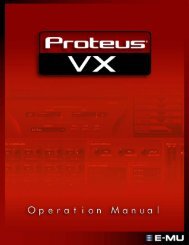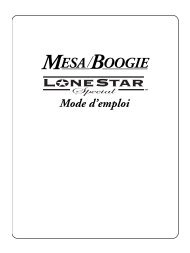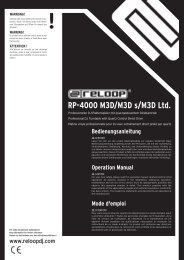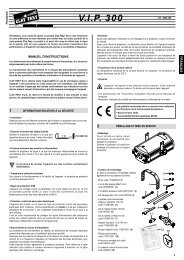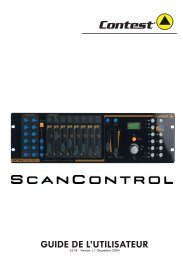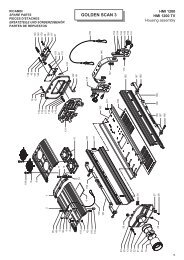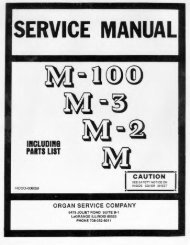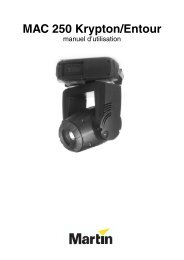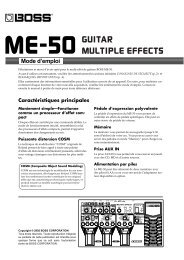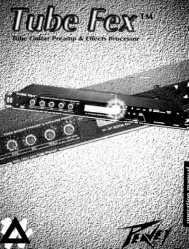Sequential Circuits Prophet-5 Service Manual - Audiofanzine
Sequential Circuits Prophet-5 Service Manual - Audiofanzine
Sequential Circuits Prophet-5 Service Manual - Audiofanzine
Create successful ePaper yourself
Turn your PDF publications into a flip-book with our unique Google optimized e-Paper software.
T .1 T LFor the most transparent operation, you will want a minimum of time between bytestransmitted to the <strong>Prophet</strong>, The faster the transfer, the truer the timing will be. Somespecific timing figures may be of use. For example, the <strong>Prophet</strong>'s scan time (for eachprogram loop) is 6 ms, or 11 ms if controls are being used. This means there is a worstcasedelay of 1 1 ms between a key being pressed and its being heard or recorded. This isnot normally detectable in the <strong>Prophet</strong>. However, sequencing adds new timing concerns,since the <strong>Prophet</strong> waits for the transfer to be completed before continuing its loop.With a 625 kHz clock, 9 serially-formatted bytes will take only 158,^ us (1.6 us X 99bits). But if they are spaced 1 ms apart, the whole transfer will about double the worstcaseloop time. It is more reasonable to use the fastest clock possible, and allow up to100 us between bytes. This will have a negligible effect on the <strong>Prophet</strong>'s loop.The <strong>Prophet</strong> isprotected from being "hung-up" by extremely slow or nonexistent data.Its time-out software declares an error and ignores the whole message if more thanabout k milliseconds elapses between bytes.When the message iscomplete, the <strong>Prophet</strong> places this data into its "Scratchpad" RAMtable, playing the notes as if they came from its own keyboard. Even while receivingfrom the external sequencer the <strong>Prophet</strong>'s keyboard remains active and can be usednormally (unless the sequencer TRANSPOSE function is enabled, see STATUS 2). Ofcourse you still have a five-voice maximum. So if you, for example, play on thekeyboard while the sequencer is playing, you will "steal" voices from the sequence.If no program change is desired, you can either transmit the last program number, orthe code FF(H) which the <strong>Prophet</strong> simply ignores. Except for the FF code, the <strong>Prophet</strong>will sense an error ifeither of the two MSBs of the program byte are set.NOTE. Be sure the <strong>Prophet</strong> is switched to PRESET mode when you want to changeprograms.(Status B can be used for changing the program only ."short" keyboard data. See below.)Status E can be used for receiving9-6 STATUS 2: TRANSPOSE ONThis status byte isused to enable the sequencer transpose function. Once the <strong>Prophet</strong>receives code 0^(H), you can transpose the entire playback sequence over a four-octaverange by just hitting a key between CO and C^ on the <strong>Prophet</strong>. The transposition isequal to the interval between C2 and the key played. For example, to transpose down afifth, hit Fl. To transpose up a major seventh from the original key, hit B2. Totranspose back to the original key, hit C2.9-7 STATUS 3: SAVE TO TAPEThis status byte isused to extract the contents of the Non-Volatile program RAM fromthe <strong>Prophet</strong>, without using the independent CASSETTE interface. Organized as ^0 2^byteprograms, NV RAM uses 960 of its102^ (IK) bytes. The least-significant seven bitsof each byte represent a programmable pot setting of -127 steps, while the MSBrepresents a switch setting (l=on, O=off), The <strong>Prophet</strong> has another area of RAM called"Scratchpad" in which the current status of the machine isregistered. When selecting aprogram in PRESET mode, a set of 2^ bytes is transferred from NV RAM to theScratchpad, with the "pot" bits filling the pot table and the switch bits being regroupedinto the switch status table. Here is how the pot and switch bits are grouped in each NVprogram:9-^TMiOOOD.2 10/81



